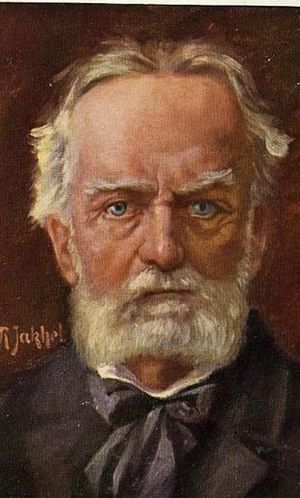Josip Stritar facts for kids
Quick facts for kids
Josip Stritar
|
|
|---|---|

Stritar, 1920s painting
|
|
| Born | 6 March 1836 Podsmreka, Austrian Empire (now Slovenia) |
| Died | 25 November 1923 (aged 87) Rogaška Slatina, Kingdom of Serbs, Croats and Slovenes (now Slovenia) |
| Occupation |
|
| Notable works | Zorin, Gospod Mirodolski, Rosana, Sodnikovi |
Josip Stritar (born March 6, 1836 – died November 25, 1923) was an important Slovene writer, poet, and playwright. He was also an essayist, publisher, and translator. He is known for being one of the first people to write about art and beauty in a critical way in Slovenia.
Life of Josip Stritar
Josip Stritar grew up in the small village of Podsmreka in Lower Carniola, which is now part of Slovenia. His parents were Andrej Stritar and Uršula Jakič. He went to school in Ljubljana when he was young.
In 1855, Stritar moved to Vienna, the capital of Austria, to continue his studies. He finished his education in 1874. After that, he started working as an assistant teacher at a school called Hernals Gymnasium. Later, in 1878, he became a professor in Josefstadt. He taught there until he retired in 1901.
Stritar returned to his home country, the Slovene Lands, in January 1923. The local government in Ljubljana gave him a house in Rogaška Slatina to honor his work. He lived there for a short time until he passed away. Josip Stritar was buried in Ljubljana.
Josip Stritar's Literary Work
Josip Stritar made many important contributions to Slovene literature. One of his key works was the introduction he wrote for the 1866 collection of France Prešeren's poems. In this introduction, Stritar explained how important Prešeren's poems were for developing a strong Slovene national identity.
During the 1880s and 1890s, Stritar spent a lot of time translating parts of the Bible into Slovene. These translations were published by the British and Foreign Bible Society.
Even though he lived most of his life in Vienna, people in Slovenia greatly admired his work. He was even made an honorary member of the Yugoslav Academy of Sciences and Arts in 1919.
Commemoration and Legacy
Today, a main street in Ljubljana is named after Josip Stritar. This street, called Stritarjeva ulica (Stritar Street), leads from the Triple Bridge to Town Square.
The house where Stritar was born has been replaced by a new building. However, a granary from his time is still standing. This old granary has been turned into an ethnographic museum, which means it shows how people lived and worked in the past.
See also
 In Spanish: Josip Stritar para niños
In Spanish: Josip Stritar para niños

